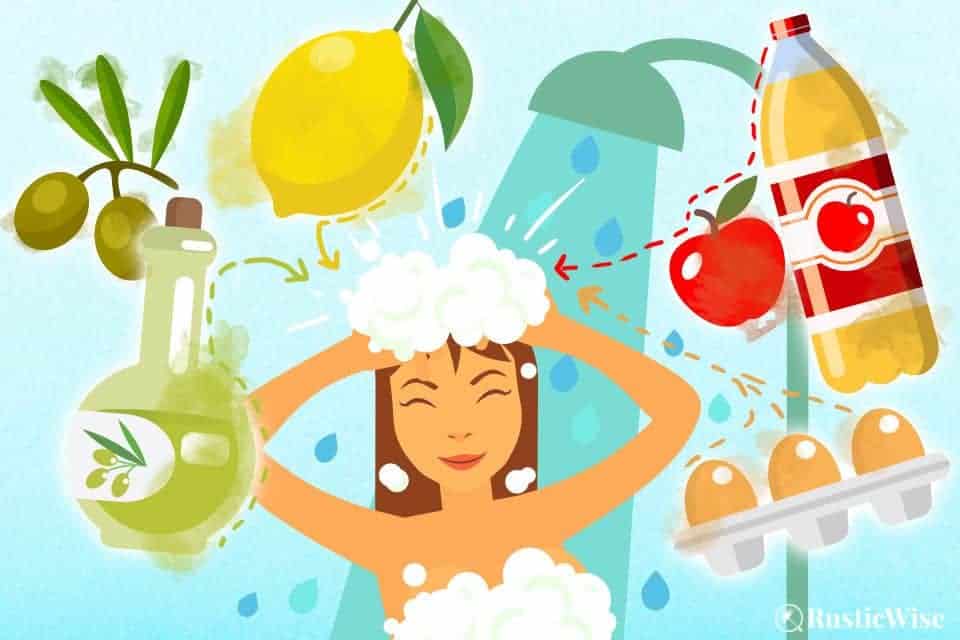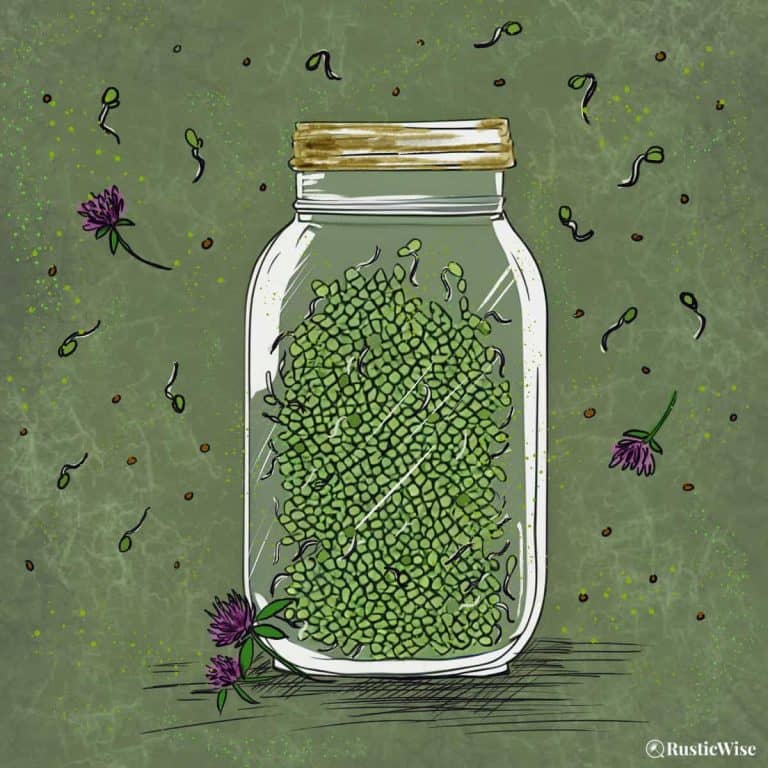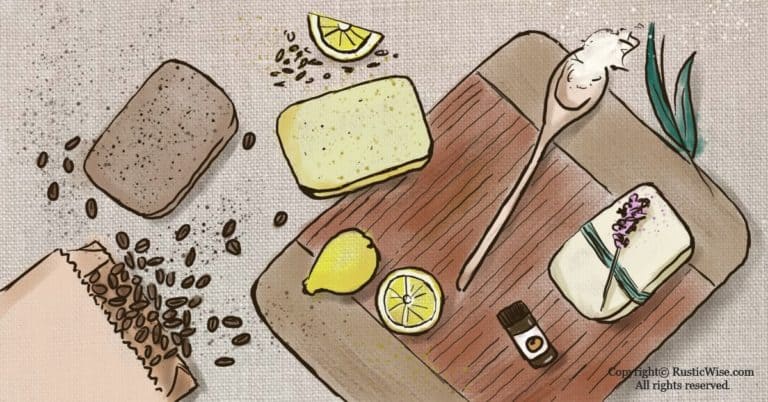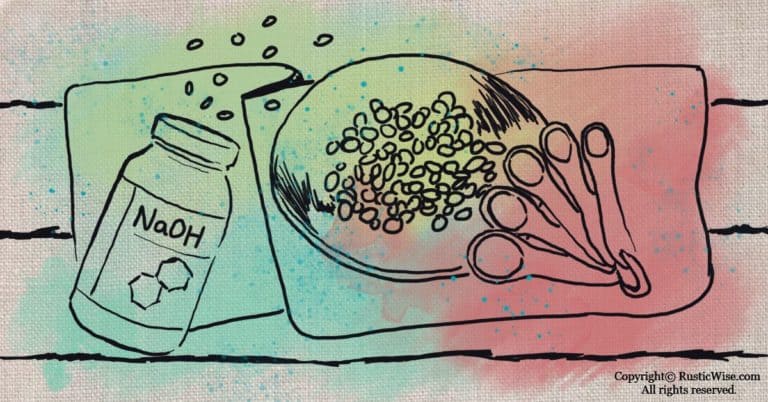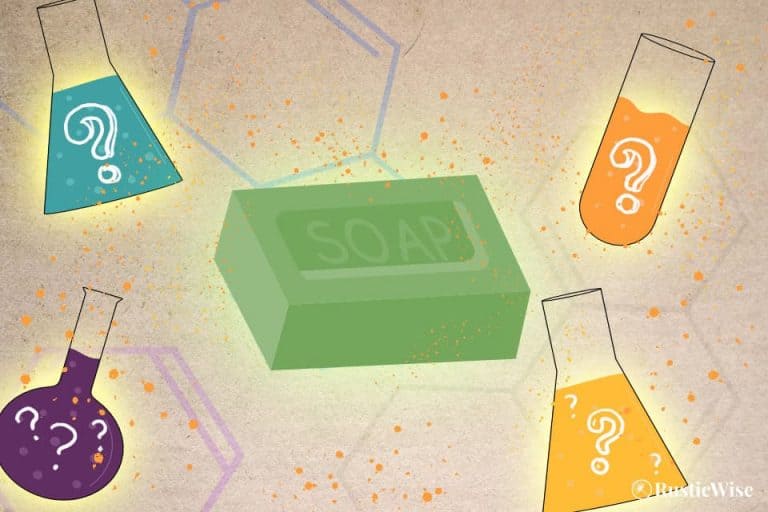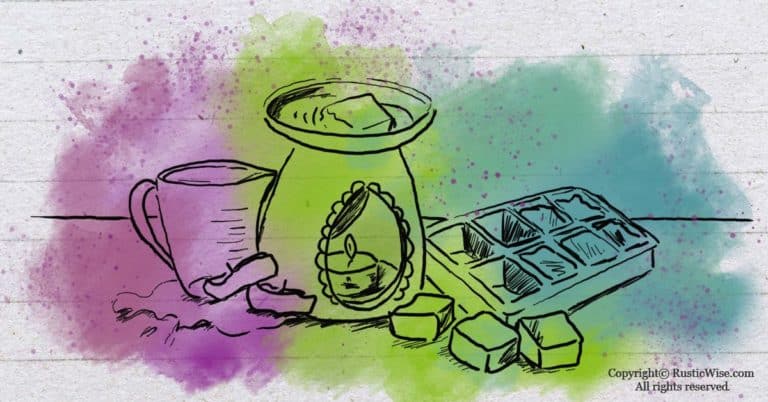Easy Homemade Shampoo Without Castile Soap (With Simple Ingredients)
If you’re trying to ditch the chemicals in your commercial shampoo, many other DIY shampoos use Castile soap. While Castile soap is a workhorse for cleaning, and I love it for its versatility, it might not work for everyone’s hair. Here’s a simple recipe for making homemade shampoo without Castile soap (and one for conditioner too!).
Going the natural route requires a bit of research. Many natural shampoos require a plethora of fancy essential oils, clays, or other ingredients most people don’t have. The recipe we’re sharing with you requires just a few simple ingredients you’ll probably have at home: eggs, olive oil, lemon juice, and apple cider vinegar.
Roll up your sleeves and get ready to make a natural shampoo for healthy locks using ingredients that really work!
What is Castile soap exactly?
Castile soap has been around for centuries. Originally, it was an olive oil based bar soap. Nowadays, Castile soap comes in liquid and bar soap. While olive oil remains a key ingredient, it’s often made from a mixture of vegetable oils, including coconut oil, and palm oil.
People love it for its plant-derived ingredients, which are gentle on the skin and environment. Castile soap doesn’t contain harsh chemicals or synthetic additives common in many commercial soaps or detergents.
It’s a versatile product that is a mainstay in the world of DIY and natural products as you can use it for everyday household cleaning, yet it’s still mild enough for those with sensitive skin. Castile soap is a common ingredient in homemade personal care products, such as natural liquid hand soaps and body washes.
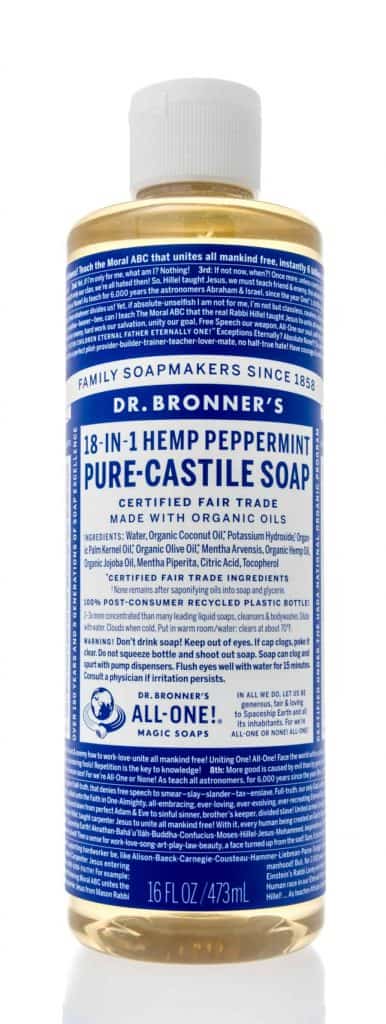
Credit: ©homank76/123RF.com
Is Castile soap good for hair?
Castile soap can work as a shampoo base for a DIY liquid shampoo, but it’s not a perfect solution for everyone. If you scour the internet for easy, natural recipes, most call for liquid Castile soap.
This is because this multi-purpose and natural soap is widely available, and does a great job of cleaning.
But when it comes to haircare, a good shampoo does more than simply clean. A good shampoo also maintains the scalp and hair’s natural protective acidity. It nourishes locks without weighing it down.
While Castile soap can keep hair clean, your locks might look or feel lack-luster. So, if you find Castile soap works for your hair, that’s great. Others may experience tangled locks, dull hair, or an irritated or itchy scalp.
Your hair type (short or long, coarse or fine, straight or curly) and your scalp condition (oily or dry), determine which hair shampoos work best for you.
This is mainly because of Castile soap’s alkalinity—most have a pH of between 9 and 10. Hair and skin are naturally acidic (we’ll cover pH in the next section).
Even Lisa Bronner of Dr. Bronner’s Castile soap does not recommend using it on color treated hair as it opens the hair follicles, making color fade quickly.¹ It may also dry hair (which is not ideal if you already have dry hair)!
Tip: Don’t use pure undiluted liquid Castile soap directly on hair. The concentrated formula works best if diluted first. Make a solution of 1/2 tablespoon Castile soap with 1 cup of water before working into hair. Follow up with an apple cider vinegar rinse.²
How pH affects scalp and hair health
A good shampoo needs to do more than simply clean if you want healthy, shiny locks. It also needs to close hair cuticles and not disrupt the skin and scalp’s natural acidic pH.
Here’s a quick refresher on the pH scale. The pH (power of hydrogen) scale runs from 0 to 14. A pH of 7 is neutral while anything lower than pH 7 is acidic. Numbers above pH 7 are considered basic, or alkaline.

The scalp’s pH is 5.5, while the hair shaft pH is 3.67.³
In a 2014 study, researchers studied 123 commercial shampoos and found out which ones had the best results for hair and scalp health.³
They concluded that shampoos that were more alkaline caused hair to be more frizzy and experience more static.
Continual exposure to more alkaline hair products may disrupt the acid mantle (a natural protective barrier) of both scalp and hair. Your scalp may feel dry or itchy. Hair becomes more dry and brittle.
Pros and cons of this natural homemade shampoo recipe
Now that we’ve talked a bit about hair and scalp health, let’s dive into this DIY shampoo recipe, shall we?
No homemade recipe is perfect, so here are a few pros and cons of this recipe.
Pros:
- Contains natural ingredients with names you can actually pronounce.
- The recipe we’ll share below is made with everyday cost-effective ingredients.
Cons:
- You’ll need to spend a couple minutes to whip up a batch of fresh shampoo. Although the work to blend these ingredients isn’t difficult, it just takes a few extra minutes (plus you’ll need to wash a couple extra dishes).
- Since the ingredients are all natural with no preservatives, you’ll need to make a fresh batch every time you want to clean your locks.
How these natural ingredients help with your hair and scalp
Since we know that the ideal shampoo leans acidic, our recipe contains a few acidic ingredients (lemon juice and apple cider vinegar).
Here’s how this all-natural shampoo works:
- Lemon juice: Bumps up the acidity, and adds a fresh citrus scent. Lemon juice is also a great natural cleanser.
- Apple cider vinegar: Apple cider vinegar is acidic and helps balance out the pH levels of scalp and hair. It works to remove impurities such as oil and dirt, while also closing hair cuticles for shinier, smoother hair. It can also combat dry, itchy scalp or dandruff.⁴
- Egg white: The white part of an egg has special enzymes which work to reduce oils and combat dandruff. Egg whites are also high in protein. The hair shaft is largely comprised of keratin, a type of fibrous protein. Protein may help strengthen hair and boost shininess.⁴
- Egg yolk: The egg yolk is highly moisturizing, and an excellent source of biotin, folate, protein, iron, and vitamins A and E—all good building blocks for healthy hair. Egg yolk acts as a great hair conditioning agent. A 2018 study found that the yolks from chicken eggs contain peptides that are beneficial for stimulating hair growth. This may be beneficial to those with Alopecia or hair loss.⁵
- Olive oil: A lightweight oil that’s great for nourishing dry hair, olive oil is also high in vitamins A and E.
Tip: Having healthy hair starts from the inside out. Making sure you receive enough protein through your diet ensures your body can build and repair tissues in the body including hair and nails. Egg whites are a good source of protein and contain all essential amino acids.⁶
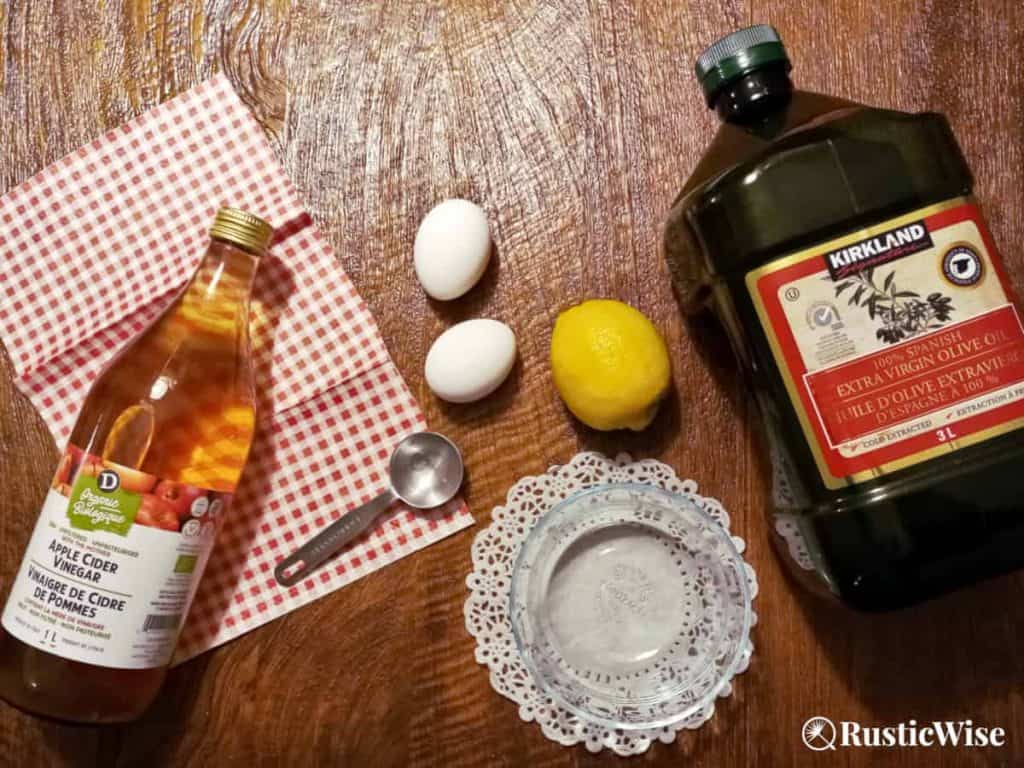
Homemade shampoo without Castile soap recipe
Here’s a DIY egg shampoo recipe you’ll love.
I found the following Castile-free shampoo and conditioner recipes from the UC Berkely School of Public Health.⁴ I like how it uses ingredients most people will have at home.
Many other DIY shampoos feature a lot of coconut oil. While coco oil can be a great hair treatment or mask, some people say it leaves their hair feeling greasy or weighed down.
This is an easy and effective shampoo that works well for most hair types. Whether you have oily hair, damaged hair, or normal hair, this shampoo helps clarify scalp and hair without leaving it feeling greasy.
Supplies you’ll need:
- Blender or mixer
- Small bowl
- Empty clean cup or bottle
Ingredients:
- 2 tablespoons olive oil
- 1 egg (yolk + whites)
- 1 tablespoon lemon juice
- 1 teaspoon apple cider vinegar
- Measure and combine all ingredients. Blend until well mixed.
- Pour the DIY shampoo into a small cup or bottle.
- Wet hair and shampoo with the mixture. Start at the roots and massage into scalp. Rinse well with water.
- Dump out any leftovers (this mixture doesn’t keep well!).
Homemade conditioner without Castile soap recipe
Follow your homemade DIY shampoo with a natural and nourishing egg yolk conditioner.
Supplies you’ll need:
- Blender or mixer
- Small bowl
- Empty clean cup or bottle
Ingredients:
- 1 egg yolk (save the egg white for cooking)
- 1/2 teaspoon olive oil
- 3/4 cup lukewarm water
- Separate the yolk from the whites. Save the egg white for a healthy snack, or another purpose.
- Beat the egg yolk. Add the olive oil and mix until well combined. Add the lukewarm water and mix until all ingredients are combined.
- Pour into a cup or bottle.
- Massage the rich conditioner into clean damp hair (following your shampoo). Let mixture soak into hair for around 10 minutes.
- Rinse thoroughly.
Use your homemade shampoo without Castile soap as often as you would your conventional shampoo.
New to making soap? 🧼❓
👉We have a fantastic overview on the whole soapmaking process here: read our Timeless Guide To Soapmaking.
If you would like to see our soapmaking posts organized by topic type, see our Soapmaking Collection.

References
- Bronner, Lisa (20 November 2010). “From Shampoo to Soap – My Story,” Going Green with Lisa Bronner. Accessed January 2022.
- Dr. Bronner, Dilutions Cheat Sheet for Dr. Bronner’s Pure-Castile Soap, https://www.drbronner.com/all-one-blog/2017/06/dilutions-cheat-sheet-dr-bronners-pure-castile-soap/. Accessed January 2022.
- Gavazzoni Dias, Maria Fernanda Reis et al. “The Shampoo pH can Affect the Hair: Myth or Reality?.” International journal of trichology vol. 6,3 (2014): 95-9. doi:10.4103/0974-7753.139078 https://www.ncbi.nlm.nih.gov/pmc/articles/PMC4158629/
- UC Berkely School of Public Health, Do It Yourself Beauty Recipes, https://cerch.berkeley.edu/. (https://cerch.berkeley.edu/sites/default/files/do_it_yourself_beatuy_recipes.pdf.) Accessed January 2022.
- Nakamura, Toshio et al. “Naturally Occurring Hair Growth Peptide: Water-Soluble Chicken Egg Yolk Peptides Stimulate Hair Growth Through Induction of Vascular Endothelial Growth Factor Production.” Journal of medicinal food vol. 21,7 (2018): 701-708. doi:10.1089/jmf.2017.4101 https://pubmed.ncbi.nlm.nih.gov/29583066/
- Frothingham, Scott (04 April 2018). “Egg White for Hair,” Healthline. Accessed January 2022.

Author: Theresa Tesolin
Theresa is co-founder of RusticWise. She helps people unleash their inner DIY spirit by encouraging them to get dirty and make or grow something from scratch.

